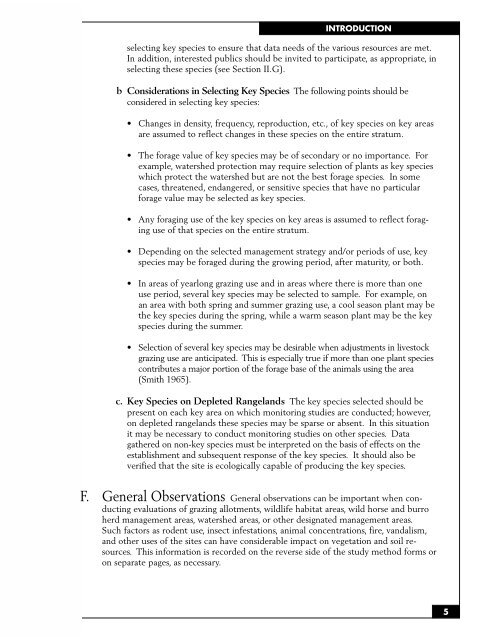Sampling Vegetation Attributes - Natural Resources Conservation ...
Sampling Vegetation Attributes - Natural Resources Conservation ...
Sampling Vegetation Attributes - Natural Resources Conservation ...
You also want an ePaper? Increase the reach of your titles
YUMPU automatically turns print PDFs into web optimized ePapers that Google loves.
INTRODUCTION<br />
selecting key species to ensure that data needs of the various resources are met.<br />
In addition, interested publics should be invited to participate, as appropriate, in<br />
selecting these species (see Section II.G).<br />
b Considerations in Selecting Key Species The following points should be<br />
considered in selecting key species:<br />
• Changes in density, frequency, reproduction, etc., of key species on key areas<br />
are assumed to reflect changes in these species on the entire stratum.<br />
• The forage value of key species may be of secondary or no importance. For<br />
example, watershed protection may require selection of plants as key species<br />
which protect the watershed but are not the best forage species. In some<br />
cases, threatened, endangered, or sensitive species that have no particular<br />
forage value may be selected as key species.<br />
• Any foraging use of the key species on key areas is assumed to reflect foraging<br />
use of that species on the entire stratum.<br />
• Depending on the selected management strategy and/or periods of use, key<br />
species may be foraged during the growing period, after maturity, or both.<br />
• In areas of yearlong grazing use and in areas where there is more than one<br />
use period, several key species may be selected to sample. For example, on<br />
an area with both spring and summer grazing use, a cool season plant may be<br />
the key species during the spring, while a warm season plant may be the key<br />
species during the summer.<br />
• Selection of several key species may be desirable when adjustments in livestock<br />
grazing use are anticipated. This is especially true if more than one plant species<br />
contributes a major portion of the forage base of the animals using the area<br />
(Smith 1965).<br />
c. Key Species on Depleted Rangelands The key species selected should be<br />
present on each key area on which monitoring studies are conducted; however,<br />
on depleted rangelands these species may be sparse or absent. In this situation<br />
it may be necessary to conduct monitoring studies on other species. Data<br />
gathered on non-key species must be interpreted on the basis of effects on the<br />
establishment and subsequent response of the key species. It should also be<br />
verified that the site is ecologically capable of producing the key species.<br />
F. General Observations General observations can be important when conducting<br />
evaluations of grazing allotments, wildlife habitat areas, wild horse and burro<br />
herd management areas, watershed areas, or other designated management areas.<br />
Such factors as rodent use, insect infestations, animal concentrations, fire, vandalism,<br />
and other uses of the sites can have considerable impact on vegetation and soil resources.<br />
This information is recorded on the reverse side of the study method forms or<br />
on separate pages, as necessary.<br />
5

















